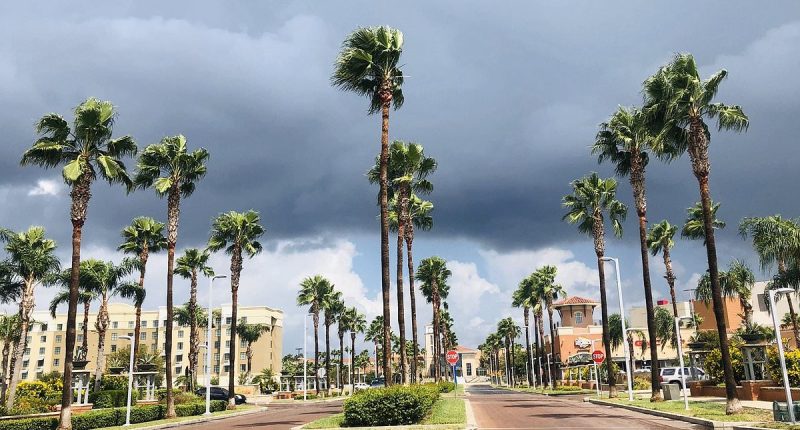Share this @internewscast.com
I squirmed as oil and fat oozed out of the lard-soaked Mexican sandwich wriggling in my hand, bloated with heaped servings of meat and cheese.
I looked down at my dinner — in addition to the popular sincronizada, which is like a quesadilla, I still had to make my way through four tacos, a bean soup, and a 17oz full-sugar soda before the night was out. And then we might even go for a sweet treat!
I was at a popular food truck in McAllen, Texas, where just one whiff of the food sets off painful memories of heartburn and stomach upset.
A local told me my entree was prepared by ‘bathing the wrap in lard,’ and I vowed to go to the gym the next day to try and burn off what must have easily been a 2,000-calorie meal.
But while this was a very rare indulgence for me, I learned that a large late dinner like this — it was nearing 11pm — was the norm for people here.
There were picnic tables full of families surrounding a local favorite food truck. Everyone from toddlers to grandparents were getting their fill of heaped servings — often topping it off with a dessert of ice cream.
My guide, David Norec, a local obesity activist, told me this was a typical scene and, shortly following dinner, people would go to bed ‘without walking any of it off’.
It may be habits like this that have earned McAllen, home to 148,000 people, the title of most obese town in America for the last seven consecutive years.

McAllen, home to 148,000 people, has held the title for the most obese town in America for the last seven consecutive years

In addition to the popular sincronizada, which is just like a quesadilla, I still had to make my way through four tacos, a bean soup, and a 17oz full-sugar soda before the night was out
According to CDC data, the McAllen area has an estimated 44.6 percent age-adjusted prevalence of obesity among people 18 and older, while Hidalgo County, home to McAllen, has an age-adjusted prevalence of 47.6 percent.
The US national average is 40.3 percent.
Adult men in Hidalgo County weigh 216lbs on average, according to a two-year study published in 2019, while women weigh 186lbs on average. Experts fear that if this study was repeated today, the numbers would be even higher.
For comparison, nationwide the average man weighed 199.8lbs, according to 2021 data — the latest available — while the average woman weighed 170.8lbs.
Additionally, a separate WalletHub study published last month found 45 percent of adults in McAllen, which sits about 13 miles from the Mexican border, were classified as obese. Another 31 percent were overweight but not obese.
The city is also home to the second-highest share of obese teens and the fifth-highest share of obese children.
While I was in McAllen, David gave me a list of the most popular places to eat in the area — and what a normal day of eating looks like.
A typical day for me in New York City starts with a breakfast of two eggs, leftovers for lunch and a dinner of either steak and rice or fish and potatoes.

David Norec is fighting to reduce the obesity rate in McAllen


Locals in the town said there had been some efforts locally to slash the obesity rate. Pictured above is Estefania (left) and Carmen del Leno (right)

BREAKFAST: For breakfast, people tend to head to fast food chain Stripes for their meal, normally a taco that is about 540 calories
But in McAllen, my day began with a lard-heavy bacon and egg taco from the fast food chain Stripes — coming in at 540 calories with 25 grams of fat.
While there, I met two locals, Isaac and Kaylee.
Isaac told me they go there for breakfast two to three times a week: ‘It’s quick and easier than cooking,’ he explained.
But if people aren’t in the mood for a breakfast taco, David said they may go to Paris Bakery — which serves sugary conchas, a brioche-like bun topped with a sweet paste.
They have anywhere from one to four in a sitting, with each containing 250 to 300 calories.
Lunch was more fast food. I ate a bacon and cheese Whataburger, accompanied by French fries and a medium soda.
This came to a total of 1,540 calories and 58 grams of fat.
The chain is located on tenth street, which is the main fast food highway.
Other fast food places line the street, including Burger King, Chick-fil-A, McDonald’s, Taco Bell and Popeye’s — to name a few. As I drew up, drive thrus were bustling with cars turning up to grab a quick bite.
Dinner was back to the taco truck to chow down on another massive meal under bright iridescent streetlights.
According to nutrition website NutritionX, that accounted for an estimated 1,600 calories and 62 grams of fat.
By the end of the day, I had consumed a grand total of about 3,680 calories and 145 grams of fat.
The FDA says that moderately active men like me need about 2,600 calories a day — about 1,000 less than I had eaten. Those who aren’t active should only eat around 2,200 calories.
For women, the recommendation is even lower, between 1,800 and 2,000 calories per day.
For fat consumption, the FDA says people following a 2,000 calorie-a-day diet should not consume more than 44 to 78 grams of fat per day – far lower than my 145 grams.
Visiting McAllen, the obesity epidemic was evident on almost every street corner.
And while shocking to see, it comes with many repercussions that are less visible.
Recognized as a condition in 2013, studies have since shown obesity raises the risk of a multitude of life-shortening conditions, including heart disease, stroke and high blood pressure.
Being overweight or obese also increases your chances of developing diabetes and, in McAllen, nearly one in five adults have the life-threatening condition.
My guide David, 47, is the youngest of eight children, of which only five remain — the other three having died from diabetes.
The family has always lived in McAllen, all the children were overweight, and they all developed diabetes. David still has the condition, but has beaten back his waistline after adopting healthy habits like replacing sodas with water and walking more regularly.

McAllen, home to 148,000 people, has had the dubious honor of being the most obese town in America for the last seven consecutive years

Two people try out the free diabetes testing clinic in a major grocery store

Trainers at OrangeTheory, a fitness center, said they work with clients to help them lose weight
The most recent death in the family happened last August, when he lost his elder sister Carmen, who was just 66 years old — and overweight.
She was diagnosed with diabetes about 13 years ago, but took little action at the time as she was working two jobs as a nurse.
Over time, her condition deteriorated, leaving her needing a partial amputation to her right foot. She then became legally blind, losing the middle area of her vision.
She was mostly confined to a wheelchair, and heartbroken she couldn’t see her grandchild.
By the end of her life, David said she was ‘ready to go’.
‘This is why we need to talk about obesity here,’ he said, ‘to try to stop this from happening again.’
David, who was overweight like all his siblings, is also battling type 2 diabetes. He has stopped taking his medications because they made him queasy, and instead tries to self-manage his blood sugar.
He is also training for a walk from McAllen, where the family has always lived, to Austin to raise awareness of the condition – a trip of about 300 miles.
While in town, I went to a grocery store where nurses were running a free diabetes screening clinic outside a pharmacy.
One nurse told me: ‘We’ve had quite a few people come today and 40 people came yesterday.
‘Sometimes, it is OK for them. But I have had a few who had not got good news, and then they panicked.’
At least four people visited the nurses in the 10 minutes I was there, all of them older individuals, and three out of the four were overweight.
At the pharmacy, its manager Tracy told me that ‘about 80 to 85 percent of what we do here’ is provide medications to treat diabetics.
She said: ‘I’ve worked around this area all my life, and people here are generally more likely to have it.’
But it’s not just adults that are affected, with Tracy also telling me some of their patients are just 12 or 13 years old.
The obesity problem has permeated nearly every facet of the town, with two men who had visited the local strip club even telling me: ‘Everyone [the strippers] was fat there, dude.’
At the nearby gym, a personal trainer said McAllen’s obesity capital of the US title is ‘why I’m here.’
Most of his clients, he says, are seeking to lose weight.
Everyone has a theory for extent of the city’s obesity problem, but many blame the greasy and fat-heavy food and long working days. Residents report regularly working 11-hour days, which leaves them little time to cook fresh, nutritionally balanced meals at home.
Some also pointed out that the area is not wealthy, with the average individual earning $28,111 per year – meaning they can’t afford healthy food, which is generally more expensive than fast, ultra-processed ingredients.

I vowed to go to the gym the next day to try and burn off what must have easily been a 2,000-calorie meal

Visiting McAllen, the obesity epidemic was evident on almost every street corner

A father and son shop at a local grocery store
There have been efforts to tackle the health crisis in the city, with town officials signing up for Michelle Obama’s ‘Let’s Move!’ Initiative in 2010.
This was a public health initiative focused on young people that encouraged healthy meals in schools and at home, and urged children to take more exercise.
There have also been efforts from town officials to combine walking and hiking trails in and around the area, and to get more people outside via a new campground with an archery range and mountain biking trail — set to open later this year.
The town has even hosted a marathon every year since 2013.
In response to his town being crowned America’s most obese for the seventh year in a row, Mayor Javier Villalobos told a local broadcaster last month: ‘I think you all know we have over 30-something miles of walking and biking trails and thousands of acres of parks.
‘We just keep on doing stuff that really promotes… but at the very end, it is up to the individual [to use them].’
David has written a book to help inspire people to exercise. Titled The Adventures of Exo and Cy – a play on the word ‘exercise’ – it follows a boy and his dog as they battle to save a city.
Readers can scan QR codes every page, which reveal exercises they can complete at home.
Ozempic may soon have an impact in the area, but many locals told me it was too expensive — even with health insurance. People also complained the drug was in short supply because some in wealthier areas were only using it to ‘lose a few pounds.’
About 70 percent of people in the county have health insurance, compared to about 92 percent nationwide.
Both Medicare and Medicaid, the largest insurers in the country, do cover Ozempic for its FDA-approved use of treating type 2 diabetes. Patients will still need to pay a copay, however, which could be $50 a quarter or $200 a year.
Pharmacy manager Tracy told me that many families struggle to pay for their diabetes medications, and often choose to go without, making Ozempic all but inaccessible.
Back at the taco truck, David told me: ‘Things need to change, but, at the moment, try as I do, I’m just not sure that they will.’
As I watched two children return for another soda from the taco truck, I had to agree.













